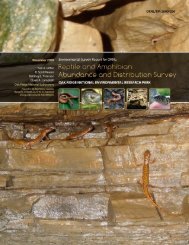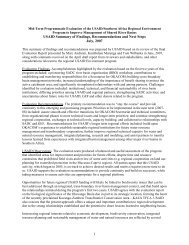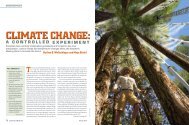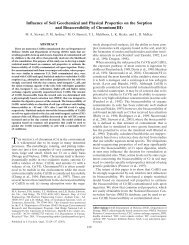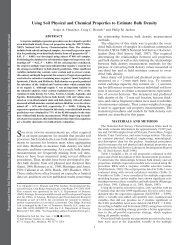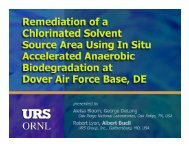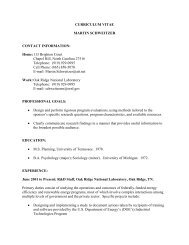oak ridge reservation physical characteristics and natural resources
oak ridge reservation physical characteristics and natural resources
oak ridge reservation physical characteristics and natural resources
Create successful ePaper yourself
Turn your PDF publications into a flip-book with our unique Google optimized e-Paper software.
12.6 BIOSPHERE RESERVE<br />
The Oak Ridge National Environmental Research Park Biosphere Reserve was designated in<br />
1988 (see Fig. 11). Biosphere reserves are areas of terrestrial <strong>and</strong> coastal ecosystems that are<br />
internationally recognized within the framework of the United Nations Educational, Scientific, <strong>and</strong><br />
Cultural Organization Man <strong>and</strong> the Biosphere (MAB) Program. Collectively, they constitute a MAB<br />
World Network. Each biosphere reserve is encouraged to fulfill three functions, as appropriate, within<br />
its management framework: (1) a conservation function (contributing to the conservation of<br />
l<strong>and</strong>scapes, ecosystems, species, <strong>and</strong> genetic variation), (2) a development function (fostering<br />
economic <strong>and</strong> human development that is socioculturally <strong>and</strong> ecologically sustainable), <strong>and</strong> (3) a<br />
logistic function (providing support for research, monitoring, education, <strong>and</strong> information exchange<br />
related to local, national, <strong>and</strong> global issues of conservation <strong>and</strong> development). The Oak Ridge<br />
National Environmental Research Park Biosphere Reserve is managed by ORNL for DOE.<br />
In addition, the Oak Ridge National Environmental Research Park Biosphere Reserve is a unit within<br />
the regional zone of the Southern Appalachian Biosphere Reserve. The MAB World Network is<br />
comprised of more than 360 biosphere reserves. The Southern Appalachian Man <strong>and</strong> the Biosphere<br />
Program is one of the most active of 47 U.S. biosphere reserves <strong>and</strong> is regarded as an international<br />
model.<br />
13. REFERENCES<br />
Awl, D. J., L. R. Pounds, B. A. Rosensteel, A. L. King, <strong>and</strong> P. A. Hamlett. 1996. Survey of Protected<br />
Vascular Plants on the Oak Ridge Reservation. ES/ER/TM-194, Oak Ridge National Laboratory,<br />
Environmental Restoration Division, Oak Ridge, TN. June.<br />
Birdwell, K. R. 1996. “A Climatology of Winds over a Ridge <strong>and</strong> Valley Terrain within the Great<br />
Valley of Eastern Tennessee.” Master’s thesis, Murray State University, Department of<br />
Geosciences, Murray, KY.<br />
Bowen, B. 2001. Tennessee Department of Environment <strong>and</strong> Conservation, letter to Leah Dever,<br />
Department of Energy Oak Ridge Operations Manager, June 18.<br />
Carlson, M. A., <strong>and</strong> R. B. Stull. 1986. “Subsidence in the Nocturnal Boundary Layer.” Journal of<br />
Climate <strong>and</strong> Applied Meteorology 25, 1088–99.<br />
Cowardin, L. M., V. Carter, F. C. Golet, <strong>and</strong> E. T. LaRoe. 1979. Classification of Wetl<strong>and</strong>s <strong>and</strong><br />
Deepwater Habitats of the United States. FWS/OBS-79/31, U.S. Fish <strong>and</strong> Wildlife Service,<br />
Washington, D.C.<br />
DOE (U.S. Department of Energy). 2005. Oak Ridge Reservation Annual Site Environmental Report<br />
for 2004. DOE/ORO/2204, Oak Ridge, TN, September.<br />
Eckman, R. M. 1998. “Observations <strong>and</strong> Numerical Simulations of Winds within a Broad Forested<br />
Valley.” Journal of Applied Meteorology 37, 206–19.<br />
Farnsworth, R. K., E. S. Thompson, <strong>and</strong> E. L. Peck. 1982. Evaporation Atlas for the Contiguous 48<br />
United States. NOAA Technical Report NWS 33, National Weather Service Office of Hydrology,<br />
Washington, D.C.<br />
30




